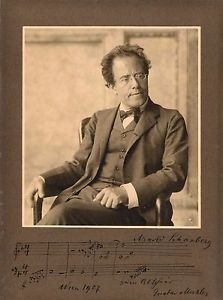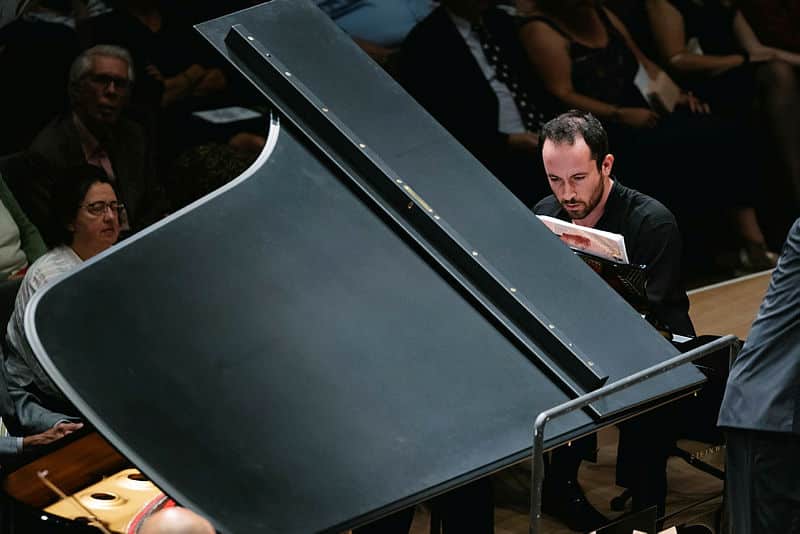Now you can hear Mahler’s version of Beethoven’s 9th
mainAn Austrian conductor, Johannes Vogel, has pulled together an orchestra in a Vienna studio to perform Gustav Mahler’s re-orchestration of Beethoven’s 9th Symphony, an adaptation that aroused uproar in February 1900 and led to the Vienna Philharmonic replacing Mahler with a ballet maestro as their chief conductor.
All Mahler did was ‘retuschen’ – tweaks of the instrumentation to project an orchestra of the 20th century rather than the 19th, but the Viennese were looking for any excuse to hound him as a heretic.
There have been previous recordings of Mahler’s version by, among others, Vasily Petrenko, Neeme Järvi and Leonard Slatkin.
Vogel’s performance is intended as a closing event for the Beethoven year, which is also the Covid year.
Broadcast details here.







Was it Neeme or Kristjan Järvi who recorded Mahler’s arrangement of Beethoven’s 9th? I don’t know of any recording of the 9th by Neeme.
What about Paavo?
Paavo with Kammerphilharmonie Bremen were, and probably still are, on a kind of semi-authentic reductionist trip, making Beethoven sound like Gin Fizz.
It was Kristjan. I have that recording and it’s really very good.
His “re-orchestration” of Schumann was far more egregious.
can’t have been worse than what Schumann did originally…
If Schumann is conducted properly with the right sized orchestra, the music does not sound muddy.
One of the best performances I’ve heard of a Schumann symphony, was conducted by Slatkin using Mahler’s emendations.
In general, I am not a fan of Schumann symphonies. He could have used an orchestrator. Or, perhaps, steps he took to make the music work for the orchestra in front of him, need to be stripped away.
“Egregious”, hell! Mahler’s retouching make the Schumann symphonies much more listenable.
Listen to this:
http://www.youtube.com/watch?v=Dyd73_hdh5Y
Both are exaggerations. The differences simply aren’t that big.
what did Mahler do?
Mahler did not change any notes or alter passages. Like virtually all conductors at the time, he adjusted things for what his orchestra could do, including utilizing the valves on the horns, and additional notes that were available to the flutes. There are many changes in dynamics, something that is even done by the period-instrument groups today in order to clarify textures. There are virtually no alterations in the slow movement and we do not know about Mahler’s rubato or tempo changes.
There are also at least two versions of his “retouchings.” One was used in Germany, where apparently he had the winds in the Alla Marcia section of the 4th movement, begin from off-stage, as well as using two sets of timpani for the big climax in the middle of the first movement. This is doable if the orchestra is from an opera house, where there are more musicians than a symphony orchestra. The other version was performed in the States and the score has been available for quite some time.
It is fascinating to get a glimpse of how this music was fashioned more than 100 years ago. Ultimately, most of us today change things depending on our experience. The idea is to make it seem as if we have not altered anything at all. Szell was a master at this and there is no page that goes untouched by the Cleveland master.
Thank you, maestro, for your input! Since singers often complain about the last movement – did Mahler alter anything to accommodate them?
Mahler changed absolutely nothing in either the soloists or chorus parts.
Yes, he asked them to sing in tempo, on top of the beat.
Yes but Szell commented at length that unlike the doublings and edits he made to Schumann what Mahler did to was a complete and unwarranted re-orchestration that created a Mahler/Schumann hybrid. As I’m writing I’m listening to the Szell/CO 1958 recording of the 2nd and it is superb. The wind playing by Lifschey, Marcellus, Sharp & Goslee and Mr. Bloom’s horn solos in the second movement have rarely if ever been duplicated.
Sorry I meant the third movement!
Notation in scores is always relative, and dependent upon the understanding of the music as such by the performer, in this case: the conductor. For instance, Mahler scores are not supposed to be played literally with their extremes of dynamics, but have to be understood symbolically, and in the context of the whole (he obviously wanted to compensate for the ‘Schlamperei’ of routine performance habits). Interestingly, Brahms notated quite sparsily, knowing that notating too much does not necessarily add to a better understanding. Also interestingly, the music of the ‘old’ scores is not hindered by the restrictions of the old instruments as performances and recordings by HIP ensembles show. In Beethoven symphonies, the music is to a great extent, quite ‘abstract’, and not too dependent upon colour.
As much as I’m a card-carrying member of the Gustav Mahler fan club, I fundamentally disagree with his re-orchestration of the B9, or of works of other composers such as Schumann.
I once sang in a choir doing this Mahler version with Neeme Jarvi, & I was left cold.
The B9, one of the finest symphonies of all time, is PERFECT. Nothing needs to be altered in any way, shape or form.
You’re not obliged to listen to it.
I don’t understand the problem.
It has problems…read Weingartner’s book which details dozens of things that need careful thought. He later recanted, but many of his thoughts are still incorporated. The biggest problem is that insanely difficult contrabassoon part!
You’re right about that contrabassoon part! It takes a lot of woodshedding to prepare that part for rehearsal or audition.
I was recently told that the part is not quite as difficult on a period instrument as it is on a modern one. Even so, it’s still a serious challenge.
Did Beethoven have virtuoso contrabassoonists, or did he just do the 19th century equivalent of cut and paste from the string bass part? I don’t know, although I did once read a DMA dissertation by a string bass player. It discussed how Beethoven used to use contrabassoons to reinforce string bass lines, even when there was not a discrete contrabassoon part in the score.
No one hears the contrabassoon anyway. It’s like bassoon parts in tutti passages in Bruckner.
If played as written, it sounds entirely convincing. Also the craft in the instrumentation is entirely perfect. If played well and with understanding, there is no need for ‘touching-up’.
so thumbs up / down are back yay…. very interested to hear Mahler’s thoughts on this work
What did Mahler do? Double the winds, pump up the bass? It’s not like he added xylophones or cowbells (“More Cowbell!”).
With all the different ways B9 has been played – fast tempos or slow; small orchestration or large; old instruments or modern – what would be the fuss these days?
no cowbells?! then it’s not Mahler lol
Fernorchester, Rute
Fernorchester, organ, church bells
Rute, Posthorn
Sleigh bells
Cowbells, hammer
Rute, mandolin, guitar, cowbells, church bells
Fernorchester, organ, harmonium, mandolin
It seems Mahler’s 5th and 9th are the odd ones out?
You forgot the slapstick in the 3rd movement of the 5th.
I’m a flute player, and we have played Beethoven 9 every New Year’s Eve for I think 10 years, plus every now & then as a season closer. I always add high notes to the 1st flute part in places where the direction of the phrase is clearly “up” but the instruments of the time apparently ran out of notes. Maybe it’s my bias as a flute player, but to my ear it sounds better. (Of course it needs to be done tastefully and well: you can’t just play the high C loud because it’s a high C, and you can’t crack it either. It needs to sound as if it was written that way, not like the flute player is trying a stunt.)
If you can bring yourself to listen to anything conducted by the hideously wicked and indubitably damnation-bound Zubin Mehta, listening to his recording of the 9th with the New York Philharmonic from approx. 1981 will show you what it sounds like when the first flutist takes such liberties and does a good job with them.
https://www.youtube.com/watch?v=jchM7-G2UqA&ab_channel=DonDiego256 (Differences/ changes are most apparent in the scherzo)
The problem with Beethoven and Haydn and Mozart symphonies is the balance between strings and the rest. A modern orchestra with a forest of strings is obviously too heavy and strangles the winds. A chamber orchestra size constitution is best, and also the hall should not be too large. Then the music will be clear and powerful where necessary.
It’s always interesting to see what a great composer in his own right did with the works of others. Don’t forget, even Toscanini and certainly Stokowski did their own retouchings of established masterpieces.
Bernstein doubled the note values of many works he performed!
Hahahaha. I remember comparing two recordings of Tchaikovsky 6: Bernstein/NY and Dutoit/Montréal.
The total time of the Bernstein disc (6th symphony only) is 58:31. The total time of the Dutoit disc (6th symphony plus Romeo & Juliet) is 59:40.
Stokowski? Don’t get me started! But I do like his orchestration of the Bach passaglia and fugue, remembering that I can hear the fantastic original organ work whenever I like.
If I were Beethoven, I would be incandescent with rage for this outrage of vandalism. You would not try to improve
The Tempest.
Be not afeard. The isle is full of noises,
Sounds, and sweet airs, that give delight, and hurt not.
Sometimes a thousand twangling instruments
Will hum about mine ears, and sometime voices,
That if I then had waked after long sleep
Will make me sleep again; and then in dreaming
The clouds methought would open and show riches
Ready to drop upon me, that when I waked
I cried to dream again.
Yes Doc, Mahler is second rate compared to Beethoven.
Mahelr’s 1st symphony 1st mvt, the entire 4th (apart from the passage at nr 12 in the 3rd mvt), the Adagietto in the 5th, the 1st mvts of the 9th and 10th, and all the orchestral songs, and Das Lied von der Erde, are all – in terms of artistic qulity – equal to anything in Beethoven and fully merit the author a comfortable seat at the musical Pantheon.
I don’t understand why we can’t accept and live happily with both versions.
Mahler is third rate and is not allowed to interfere with the composition of a vastly superior composer.
It does not need some talentless fool to improve it.
With all due respect, but this is an insane comment.
It is very important that someone be wrong.
The Pittsburgh Symphony Orchestra under William Steinberg played that favorite dozens of times between 1952 and 1978 or so. One interesting note is that Steinberg had a copy of Mahler’s original transcription. The New York City Library owns (apparently) the original transcription from Mahler’s time as Musical Director of the NY Philharmonic. One noted change or addition was the use of a Tuba to the instrumentation, plus four oboes, four or more bassoons and lots of winds. If I remember correctly the PSO for those performances augmented their orchestra to near 130 members. This is all in the record of their performances.
I find the continued interest in Mahler’s retouchings fascinating since they did not, as far as I know, include NOTATED tempo fluctuations and other added “agogic” nuances (e.g. Luftpausen) that we know from contemporary accounts he seems to have employed in everything he conducted. They were an integral part of his conducting style. Surely these would be part-and-parcel of a complete realization of Mahler’s intentions with his retouchings, just as the NOTATED tempo and agogic nuances (including such negative indications as “don’t rush” or “always the same tempo”) in Mahler’s own symphonies are integral to the music and are ignored or violated to a performance’s peril. Indeed, from my reading of critical-score revision reports it seems that tempo indications are even more fundamental than Mahler’s semi-fluid instrumentation; there are far fewer revisions in tempo and agogic niceties than there are in instrumentation through the various reworkings of a given symphony.
A good example of the tempo fluctuations you refer to is Mengelberg’s recording of Mahler 4.
The story goes that Mengelberg always slowed-down the tempo when he happened to think of his wife.
Mahler’s symphonic boa constrictors are boring as hell, even worse than boring Bruckner.
Beethoven is miles better than both. He does not need the kitchen sink in his orchestra or a brass band.
Wellington’s Victory. ‘Nuff said.
µahler alsore-orchestrated at least one of J. S. Bach’s orchestral suites,I believe the fourth.
His edition of Schumann’s second zell and Furtwaengler) is of interest also because its adagio sounds a bit Mahlerian, like that of the opiano quartet, and of John Knowles Paine’s first symphony, Mehta/NYPO, though not as uncannily Mahlerian as Hans Rott’s symphony in E.
Please, do remove your gloves.